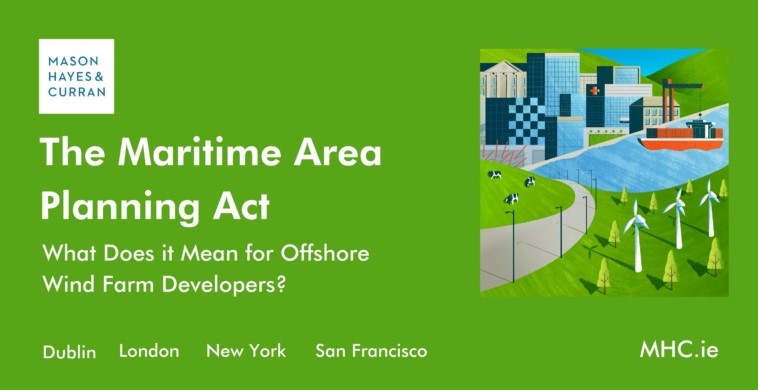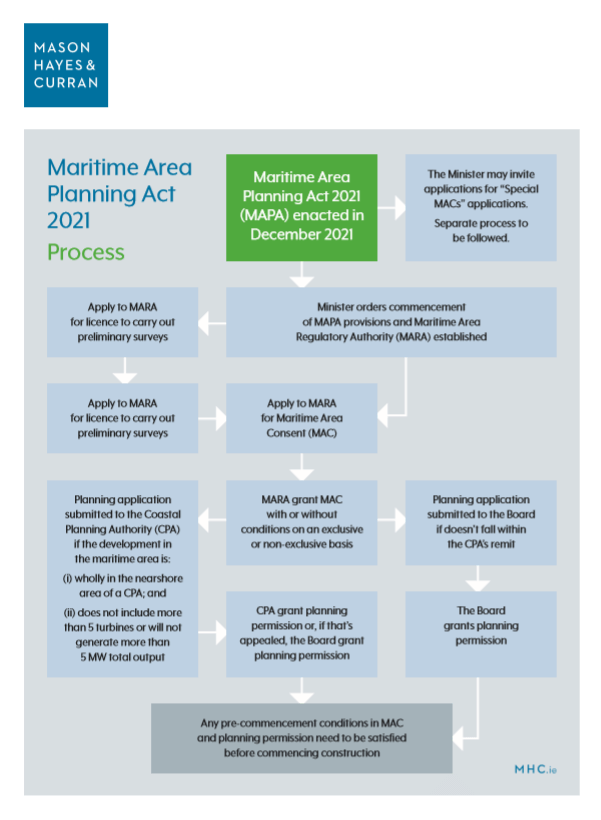
The Government has passed legislation reshaping the consenting regime for development in the maritime area. According to a recent Government press release, the Maritime Area Planning Act “represents the biggest reform of marine governance since the foundation of the State…. and will be a key enabler of decarbonisation of Ireland’s energy sources and the development of offshore energy”. This includes offshore wind energy, of which Ireland has an ambitious target to achieve 5GW by 2030.
After being expedited through Seanad Éireann, the legislation was enacted by the President on 23 December 2021. The provisions within the Maritime Area Planning Act 2021 (MAPA) will come into force on day(s) appointed by order by the Minister for the Department of Housing, Local Government and Heritage (Minister). The new regime under MAPA will apply to Ireland’s “maritime area”. This is defined as the area of sea extending from the high water of ordinary or medium tides of the outer limit of the continental shelf and includes the Exclusive Economic Zone (EEZ) of the State.
What process will a developer now need to follow under this new regime to receive consent to construct and operate an offshore wind farm?

Apply for a Maritime Area Consent
Once the legislation comes into force, a wind farm developer seeking to construct and operate a development on a publicly owned part of the maritime area will need to apply for a Maritime Area Consent (MAC). There are limited exceptions, such as the developer already holding a foreshore lease or licence under the Foreshore Act 1933 (the 1933 Act) for the proposed development.
A new authority, the Maritime Area Regulatory Authority (MARA), is to be established to determine MAC applications. The application must be in a specified form and accompanied by the relevant fee. MARA must, so far as reasonably practicable, determine the application within 90 days following satisfaction of the application requirements. It must have regard to specific criteria when determining the application. MARA may grant the MAC, in whole or part, or refuse the application and may attach conditions to the MAC. Except in very limited circumstances, an application for leave to judicially review the validity of a MAC must be brought within an 8-week period beginning on the date of publication by MARA of the decision.
The developer may need to pay a levy for the ongoing benefit afforded by a MAC, in accordance with a levy framework to be developed by MARA. MACs can be granted allowing the relevant maritime area to be used exclusively or not exclusively for the proposed maritime usage. MACs are also conditional unless and until development consent has been granted which is applied for under a separate consenting process. MARA may require applicants to alter their applications to ensure there is no conflict between multiple applications or if the application is for the same maritime area, arrange for the maritime option in that area to be auctioned in a closed tendering process.
A MAC may also be terminated in circumstances where the corresponding planning application is refused and no further step can be taken to challenge that refusal.
Apply for planning permission to either the Coastal Planning Authority or An Bord Pleanála
Once the first hurdle of the MAC has been achieved, what next? If the proposed development is for more than 5 turbines or a total output of more than 5MW, a planning application must be made to An Bord Pleanála (the Board). For smaller wind energy developments, a developer will only be required to submit their planning application to the local planning authority - the Coastal Planning Authority (CPA), rather than the Board, if the development is wholly within the CPA’s “nearshore area”. Broadly, this is the area below the line of high water, the high water mark (HWM), of ordinary or medium tides of:
- The sea, every tidal river and tidal estuary and
- Does not extend further than the prescribed distance from the nearest point of the HWM
If no such distance is prescribed for the time being, the distance is three nautical miles from the nearest point of the high-water mark. The usual planning application process applies for the CPA process, including the right to appeal to the Board.
Where the planning application is to be submitted directly to the Board, rather than the CPA, the developer will need to follow a process similar to the planning process for Strategic Infrastructure Developments. This includes procedural requirements such as undertaking pre-application consultations with the Board, preparation of an Environmental Impact Assessment Report and Appropriate Assessment Reports.
The CPA and Board must have regard to specific criteria when determining the application, including the National Marine Planning Framework. There are additional planning conditions the CPA or Board may attach to a planning permission for such development. There is also a procedure for making alterations to a planning permission granted by the Board. In seeking to keep the process moving, if a Judicial Review (JR) is brought against the MAC, the CPA and Board must still determine the planning application or appeal, as applicable. That said if permission is granted, it will not come into effect unless and until the JR proceedings against the MAC are finally dismissed by the Courts or withdrawn.
Can you carry out preliminary surveys?
The Minister will continue to have the power to grant foreshore licences for marine surveys until the licence provisions in MAPA come into force and MARA is established. After that date, a licence application for certain uses such as carrying out certain marine surveys in support of a planning application to the CPA or Board for an offshore wind farm will need to be submitted under MAPA. To obtain such a licence, a developer must apply to MARA using the specified form of application and accompanied by the relevant fee. MARA must, to the extent that is practicable to do so, determine a licence application not later than 30 days after the day on which MARA is satisfied that the applicant has complied with the relevant application requirements. A licence can be refused or granted with or without conditions.
National Marine Planning Framework
The National Marine Planning Framework (NMPF) is the overarching framework for decisions and will be a key consideration for decision makers under MAPA. All applications for activity or development will be considered in terms of their compliance with the objectives of the NMPF.
Special MAC cases
The Minister may invite MAC applications before the establishment of MARA for certain offshore wind farm developers. The developer must have either a foreshore lease, a pending application for a foreshore lease submitted before 31 December 2019, or on that date had a valid connection agreement or confirmation of eligibility for such an offer. Now that MAPA has been signed into law, it is likely that this process of inviting MAC applications to be determined by the Minister will occur in the near future.
Are there any other rules?
MAPA is a very detailed consenting regime for maritime activities. Although we have focused on the process for offshore wind energy developments, the legislation is wider than that and includes a variety of activities for the maritime area. Also, many of the broad rules we have summarised can be tweaked by the introduction of further exceptions, or expanded upon, by further regulations introduced by the Minster.
Conclusion
With time running out to achieve renewable energy targets, the Irish Government needs to ensure that there is a transparent and robust planning system that enables wind farm developments to receive permission as efficiently as possible. The implementation of the MAPA regime will provide a detailed, comprehensive consenting regime. It runs to over 250 pages and no doubt there will be teething problems. To be effective it is essential that MARA, CPAs and the Board are given sufficient resources to make the transition as smooth as possible and to successfully navigate the new legislative architecture.
If you would like assistance navigating the new process, please contact a member of our Planning & Environment team.
The content of this article is provided for information purposes only and does not constitute legal or other advice.






